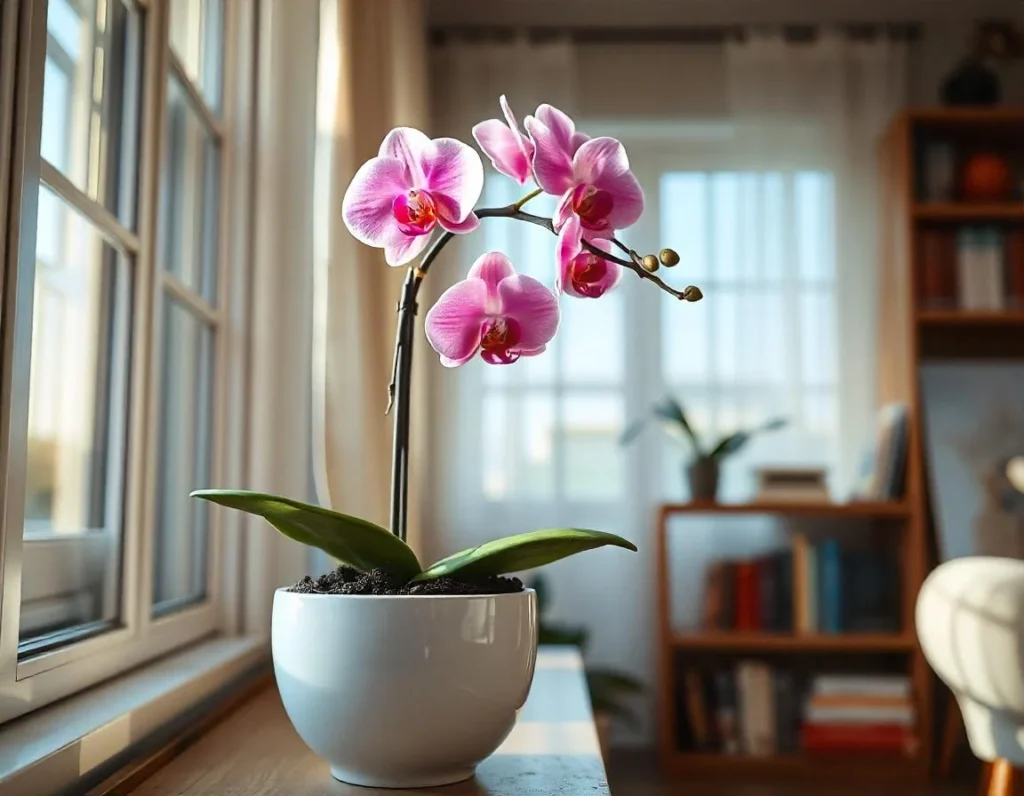Ideal light conditions for orchids are crucial, especially during winter when daylight hours decrease. Orchids are tropical flowers that thrive in consistent, bright conditions. Understanding their specific light requirements is essential to encourage year-round blooming. As winter days shorten, providing adequate light becomes even more important. Here’s a comprehensive guide on how to ensure your orchid receives the perfect amount of light to stay healthy, vibrant, and ready for flowering.
Why Light Matters for Orchids
Light is the basis of good orchid culture. Orchids need light to provide the energy for photosynthesis, which in turn promotes leaf growth, root development, and flowering. Without proper light, orchids will not be able to flower or even survive.
Signs Your Orchid Needs More Light
- Dark Green Leaves: This may sound healthy, but dark green leaves usually signal too little light.
- No Flower Spikes: Orchids will simply not flower if they are not getting enough light.
- Slow Growth: If your orchid has stopped growing, it probably needs more light..

Ideal Light Conditions for Orchids: Key Factors to Consider
1. Natural Light Exposure
Orchids are typically adapted to dappled sunlight beneath tropical canopies. The replication indoors is really important.
Best Window Orientations:
- South-Facing Windows: Ideal for maximum sunlight during winter.
- East-Facing Windows: Great for gentle morning sun.
- West-Facing Windows: are acceptable but can create heat buildup during warmer months.
- North-Facing Windows: are usually not sufficient without supplemental light.
2. LED Grow Lights
When natural light is in low supply, LED grow lights can make quite a difference.
Recommended Light Settings:
- 12-14 Hours a Day: Provide long daylight hours to simulate winter periods.
- Full-Spectrum LED Lights: Produce a light spectrum close to the sun’s.
- Distance from Plants: Keep lights 6-12 inches above the orchids to avoid burning the leaves.
3. Seasonal Adjustments
Adjusting light settings by season ensures orchids stay on a natural growth cycle.
- Winter: Reduce light exposure to 12 hours per day.
- Spring/Summer: Increase light exposure to 14-16 hours.
- Fall: Gradually reduce light back to winter levels.
How to Supplement Light During Winter
1. Move Orchids Closer to Windows
Orchids grown on window sills need to be as close to the glass for higher levels of light intensity. However, ensure that this spot has no drafts.
2. Use Sheer Curtains
Sheer curtains diffuse intense sunlight so your orchids won’t burn from leaf burns while reaping benefits from the available light.
3. Install Reflective Surfaces
Install mirrors or white panels around your orchid plants to enhance ambient light around them.
4. Rotate Your Orchids
Turn your orchids every few days to evenly distribute light.

Humidity and Temperature: Supporting Factors for Light Efficiency
Even in the best light, without the proper humidity and temperature, orchids will not do well. The following are some ways to maintain
Maintain Humidity:
- Use a Humidifier: Maintain 50-60% humidity.
- Mist Orchids: Mist them in the morning with a fine mister.
- Create a Pebble Tray:Put pebbles in a tray filled with water and place orchids on top.
Control Temperature:
- Daytime: 65-75°F (18-24°C).
- Nighttime: 60-65°F (16-18°C).
- Avoid Drafts: Keep orchids away from windows with cold drafts.
Common Light Mistakes to Avoid
1. Overexposure to Direct Sunlight
Direct sun that is too strong may scorch orchid leaves beyond restoration of their original appearance.
2. Inconsistent Light Cycles
Suddenly changing the light cycle causes abrupt disturbances in orchid growing and blooming.
3. Neglecting Supplemental Light
Using window light alone will sometimes starve an orchid during winter.
Best Orchid Types for Indoor Growing
Some types of orchids adapt to indoor living much better than others. For them, consider the following options:
- Phalaenopsis (Moth Orchid): good for beginners and does great with very little light (even in low to medium intensity)
- Cattleya: bright light indoors, indirect
- Dendrobium: like a lot of bright light; a good indoor orchid candidate
- Oncidium (Dancing Lady): moderate to bright light
Conclusion: Mastering Ideal Light Conditions for Orchids
Light is essential for successful orchid growing, particularly during the winter months. Understanding lighting needs, using supplemental lighting, and avoiding common mistakes will help to ensure orchids thrive during the calendar year. So, learn how to take better care of your orchids with these tips, and you shall see them thrive!








